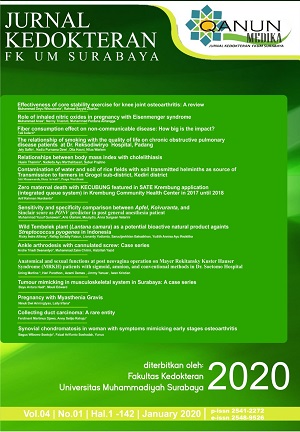Wild tembelek plant (Lantana camara) as a potential bioactive natural product againts Streptococcus pyogenes in Indonesia
Abstract
Abstract
Â
Infectious diseases are common problems in most countries. Streptococcus pyogenes is the infectious agent that causes diseases such as pharyngitis, impetigo, toxic shock syndrome, and necrotizing fasciitis. Tembelek (Lantana camara) is a wild plant that can easily be found in every ecosystem in Indonesia whether in nature or settlements and known as a plant that has an antibacterial effect but the knowledge about its potential against Streptococcus pyogenes in this past five years remain scant. The aim of this study was to determine the potentiality of Lantana camara leaves and flowers extract against Streptococcus pyogenes. In this experimental study, in vitro using Post-test Only Control Group Designed, has been done and confirmed by the Indonesian Institute of Sciences. Lantana camara leaves and flowers extracts were obtained by maceration using ethanol. The extracts were diluted into eight concentrations and their antibacterial activity against Streptococcus pyogenes was tested using the Kirby-Bauer disc then proceeded Minimum Inhibitory Concentration (MIC) test and phytochemical assay. The data processed using SPSS software version 22. The results showed that flowers extract had the most significant inhibition zone (11.85 ± 0.119 mm) compared with the leaves extract (9.54 ± 0.07 mm) at the highest tested concentration was 640 mg/ml. The MIC of both extracts was 250 mg/ml. Flavonoids, phenolic, steroids, and saponins were found in both extracts whereas, alkaloid was found only in flowers extract. In conclusion, the Tembelek plant has an antibacterial effect against Streptococcus pyogenes. Future study is needed related to its mechanism of antibacterial effect.
Â
Keywords               : Antibacterial potential, Lantana camara; Streptococcus pyogenes
Full text article
References
Agrawal, Milin K. et al. (2016). The antibacterial activity of the extracts of Lantana camara leaves against the skin disease causing bacteria. I.J. Applied Life Sc.Vol-3(2) pp 15-16
Agrawal MK, Varma A, & Goyal S (2012). Antibacterial screening of extract of the leaves of Lantana camara. Indian J.L.Sci 1(2): 97-99
Badakhshan MP, Sasidharan S, Rameshwar NJ, Ramanathan S. (2009). A comparative study: antimicrobial activity of methanol extracts of Lantana camara various parts. Pharmacognosy Research 1;1(6):348
Berwal A, Chawla K, Shetty S, Gupta A. (2019). Trend of antibiotic susceptibility of Streptococcus pyogenes isolated from respiratory tract infections in tertiary care hospital in South Karnataka. Iranian Journal of Microbiology 11(1):13
Cushnie TPT, Cushnie B dan Lamb AJ. (2014). Alkaloids: An overview of their antibacterial, antibiotic-enhancing and antivirulence activities. International Journal of Antimicrobial Agent 44(1): 377-386
Ganjewala D, Sam S, Khan KH. (2009). Biochemical compositions and antibacterial activities of Lantana camara plants with yellow, lavender, red and white flowers. EurAsian Journal of BioSciences 1;3(10):69-77.
Hay SI, Abajobir AA, Abate KH, Abbafati C, Abbas KM, Abd-Allah F, Abdulkader RS, Abdulle AM, Abebo TA, Abera SF, Aboyans V. (2017). Global, regional, and national disability-adjusted life-years (DALYs) for 333 diseases and injuries and healthy life expectancy (HALE) for 195 countries and territories, 1990–2016: a systematic analysis for the Global Burden of Disease Study 2016. The Lancet 390(10100):1260-344
Katzung BG. (2012). Basic & clinical pharmacology twelfth edition. San Fransisco: McGraw-Hill, 790-796
Keman, Deniz (2018). Investigation of molecular effect of phenolic acids on methicillin-resistant and methicillin-susceptible Staphylococcus aureus in comparison to their phenolic acid resistant mutants. MS Thesis. Izmir Institute of Technology
Kemenkes (2018). Hasil utama riskesdas 2018. Jakarta: Kemenkes RI
Kumar A, Singh S, Saini P. (2017). Assessment of phytochemical constituents and antimicrobial activity of Lantana camara L. Biosciences Biotechnology Research Asia 14(3):977-84
Kirimuhuzya, C (2009). The antimycobacterial activity of Lantana camara a plant traditionally used to treat symptoms of tuberculosis in south-western uganda. African Health Science 9(1): 40-45
Obinna F, John A, & Peter OO (2013). The Effect of Extraction Protocol on The Phytochemical and Antimicrobial Activities of Lantana camara Leaf Extract Found Within a Local Environment. Journal of Basic and Applied Chemistry 3(1): 5-10
Muharrami LK, Munawaroh F, Ersam T, Santoso M, Setiawan E, Hidayati Y, Rosidi I. Antibacterial activity of leaves extract of bukkol (Ziziphus mauritania Lam) against E. coli and S. aureus. KnE Engineering. 2019 Apr 16:180-9
Naz R., & Bano A. (2013). Phytochemical screening, antioxidant, and antimicrobial potential of Lantana camara in different solvents. Asian Pasific Journal of Tropical Disease 3(6): 480-486
Pervaiz A, Khan R, Anwar F, Mushtaq G, A Kamal M, Khan H. (2016). Alkaloids: an emerging antibacterial modality against methicillin resistant Staphylococcus aureus. Current pharmaceutical design 22(28):4420-9
Peters J, Price J, Llewelyn M. (2017). Staphylococcal and streptococcal infections. Medicine 45(12):727-34
Rempe CS, Burris KP, Lenaghan SC, Stewart Jr CN. (2017). The potential of systems biology to discover antibacterial mechanisms of plant phenolics. Frontiers in microbiology 8:42
Shakya AK. (2016). Medicinal plants: future source of new drugs. Int J Herb Med. 4(4):59-64
Strom MA, Hsu DY, Silverberg JI. (2017). Prevalence, comorbidities and mortality of toxic shock syndrome in children and adults in the USA. Microbiology and immunology 61(11):463-73
Xie Y, Yang W, Tang F, Chen X, Ren L. (2015). Antibacterial activities of flavonoids: structure-activity relationship and mechanism. Current Medicinal Chemistry 22(1):13
Authors

Qanun Medika by FK UM Surabaya is liscence under Lisensi Creative Commons Atribusi 4.0 Internasional.

